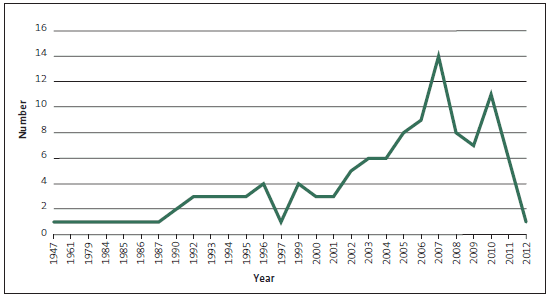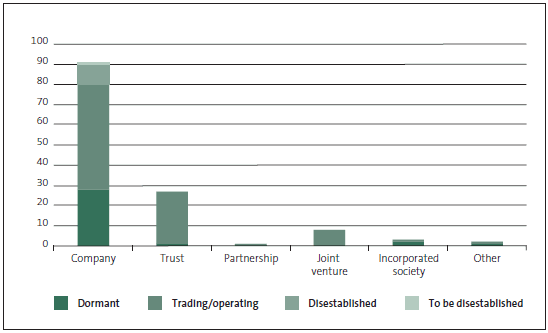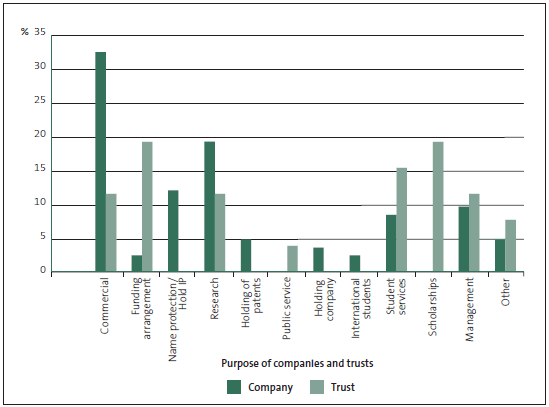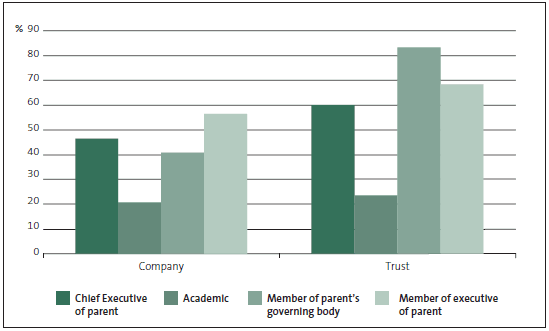Part 4: Subsidiaries of tertiary education institutions
4.1
The number of subsidiary entities in the TEI sector has increased significantly in recent years (see Figure 10 and Appendix 1). In our December 2011 report, Education sector: Results of the 2010/11 audits, we expressed our view that TEIs need to better assess the business need for their subsidiaries and their reporting about those subsidiaries.18
4.2
For our purposes, we work with an extended definition of subsidiaries.19 Under financial reporting standards in the Public Audit Act 2001, any entity that is effectively controlled by one or more public entities is itself a public entity. This extends beyond companies to include trusts, incorporated societies, and other bodies.
4.3
The governance, management, and financial sustainability of subsidiaries vary from institution to institution. It has been difficult for us to obtain a view of the sector because of the different reporting requirements.
4.4
To improve our information about TEIs' subsidiaries, our auditors collected:
- general information, such as names of parent TEIs, names of subsidiaries, administrative support arrangements, number of employees, operating status, type of entity, shareholding relationship, and purpose/core activities;
- sources of capital;
- financial information; and
- governance information.
4.5
As well as improving our own information (because we use it in risk assessments for our audit work), we wanted to ask questions that TEIs might find useful to consider. Our information remains incomplete, but, with the help of others in the sector, we will continue to improve it.
4.6
We discuss the information under four headings:
- legal structure and purpose;
- governance;
- administrative support and employees; and
- our financial observations.
4.7
At this stage, we have identified 134 subsidiaries20 in the TEI sector.21 Figure 10 shows the number of new subsidiaries established between 1947 and 2012. Most subsidiaries were established within the last 10 years, with 81 established since 2002. We have not collated information on disestablished subsidiaries, so Figure 10 does not show how long the subsidiaries trade or operate before they are disestablished.
Figure 10
Number of new subsidiaries established from 1947 to 2012

Source: Information returned to us from auditors. Includes operating and dormant subsidiaries, including those that were to be disestablished in 2012.
Legal structure and purpose
4.8
We collated information on the different types of subsidiaries (legal structure), the shareholding relationship between parents and subsidiaries, and the purpose and core activities of subsidiaries. Subsidiaries in the TEI sector include companies, trusts, partnerships, joint ventures, incorporated societies, and a small number of other structures. Figure 11 shows the subsidiary types by their current status.
4.9
Most subsidiaries are either companies (93) or trusts (27), so our discussion focuses on those types of subsidiaries.
Figure 11
Number and legal structure of subsidiaries and their status (as at 31 December 2011)

4.10
A significant number of TEI subsidiary companies are dormant (28 of the 93). This might suggest the need for more robust planning before a subsidiary is set up. Although the costs of setting up a subsidiary might be minimal, we question whether TEIs have fully considered the cumulative costs of maintaining a dormant entity against alternative means of achieving the original purpose of the entity.
Have the cumulative costs of maintaining a dormant entity been fully considered against alternative means of achieving the original purpose of the entity?
4.11
Figure 12 presents a comparison of the purposes for which companies and trusts were set up. Although there is not a direct correlation between the legal structure and the purpose of the subsidiaries:
- there is a stronger tendency to establish companies for commercial, research, and name protection/intellectual property purposes;
- trusts are largely established for funding arrangement and scholarship purposes;
- dormant subsidiaries largely exist for name protection purposes; and
- the purpose "funding arrangements" could be more clearly reported, especially the extent to which these arrangements are under the control/governance of the parent or are driven by current funding mechanisms.
Figure 12
Purposes for establishing companies and trusts

4.12
We were unable to obtain information on the reasons behind the creation or purpose of a number of subsidiaries. It is not clear where the information gap exists – whether the original purpose was not clearly outlined at the time the subsidiary was set up or records were not maintained. Not knowing the core purpose of a subsidiary makes it difficult to assess whether it is delivering the goods or services it was set up to deliver, and therefore how well it is performing.
4.13
We encourage TEIs to choose the most appropriate type of subsidiary entity, based on its purpose and business model, and to regularly reassess the costs and benefits of maintaining each subsidiary.
Governance
4.14
We collated information on the governance arrangements of subsidiaries, including board membership (the numbers and mix of external and internal board members).
4.15
The average size of a company board was four members, and the average size of a trust board was six members. Slightly more than half of the boards contained members external to the parent.
4.16
Figure 13 shows subsidiary type and percentage of internal board membership on companies and trusts. Slightly less than half of the companies and about 60% of the trusts have the chief executive of the parent on the board. A member of the governing body of the parent is on the board for most trusts, but for only about 40% of the companies.
Figure 13
Percentage of entities with different parent employees on the board (internal members)

4.17
Where the chief executive of the parent or members of the parent's governing body are on a subsidiary's board, conflicts of interest need to be appropriately managed to make transparent the level of influence over the business decisions of the subsidiary. In this context, the role that the external and internal members play on boards is important.
Are procedures in place to differentiate between the objectives of the parent and the objectives for the subsidiary?
Are there potential independence issues?
Are reserves being retained in the subsidiary for future growth?
Administrative support and employees
4.18
We collated information on the administrative support the parent provides to subsidiaries and the administrative support they provide themselves. We also collated information on the number of employees in the subsidiaries.
4.19
Nearly three-quarters of all subsidiaries (69%) rely on the parent to provide all administrative support.
How does the parent recover the cost of providing administrative services?
Are charges from the parent to the subsidiary for administrative or other support being charged on an arm's-length basis?
What resources are allocated in providing this support? Does the financial performance of the subsidiary reflect the true cost of its operations?
What tax risks does the arrangement present to the parent and the subsidiary?
What kind of incentives do these arrangements create for staff?
Do these arrangements mask inefficiencies or spare capacity or prioritisation issues in TEIs' operations?
4.20
Most subsidiaries do not have employees. However, where they do have employees, there is a considerable range – one subsidiary has 689 employees. Consideration needs to be given to who does the work in or for the subsidiary, and what facilities (if any) the subsidiary uses or needs.
4.21
The average number of employees for companies was seven,22 and for trusts it was one. Most subsidiaries simply hold investments and do not provide services.23
4.22
There is a predictable correlation between those subsidiaries that do provide services and the number of employees.
How are subsidiary employees remunerated?
Does the parent employ them or does the subsidiary?
Does the parent recover these costs or other costs associated with delivering services from the subsidiary?
Our financial observations
4.23
We collated information on the financial activities of subsidiaries. This included:
- capital injections (share capital) – including whether there was an interest-bearing or non-interest-bearing loan from the parent;
- revenue – external or intra-group;
- expenditure – external or intra-group;
- dividends paid by the subsidiary to the parent;
- current and non-current assets;
- current and non-current liabilities;
- net equity; and
- inter-group loans, including detail on amounts due from or owing to the parent and amounts due from or owing to other group entities.
4.24
We note that:
- Forty-three of 134 subsidiaries have intra-group transactions with their parent.
- On average, a capital injection of about $1.7 million has been made to subsidiaries by the TEI parent. The amount is significantly higher for those subsidiaries that have been formed for commercial purposes, where the average is about $3.4 million.
- Subsidiaries appear to be generally asset poor. Only 20 of 134 subsidiaries have non-current assets in excess of $1 million.
- Twenty-nine out of 134 subsidiaries (22%) report paying dividends to the parent/s.
- Our information on intra-group loans is sparse, and we suspect that our information on dividends is incomplete.
- From the limited information available on subsidiaries' current liabilities, it appears that a large proportion of subsidiaries depend on third-party working capital (likely to be capital from the parent).
- TEI subsidiaries are largely profitable. However, profitability might depend on subsidiaries' leveraging of parent/s' capital and administrative support.
What percentage of the total revenue and expenditure of the subsidiary is transacted with its parent or a related entity? Do these percentages justify having a separate legal subsidiary if trading is predominantly intra-group?
What is the return on investment for the parent? Is it in line with the original business plan? How is this monitored? What action is taken for under-performance?
How much are these subsidiaries leveraging off the parent's asset base? Does the parent recover these costs? What risk is the parent carrying in the event of a liquidation of a subsidiary?
Is it intended that subsidiaries retain capital? Could intra-group loans be an area of risk?
Concluding comments
4.25
It is clear that there are gaps in our information on TEI subsidiaries. They incur additional costs and place pressure on the governance and resources of parent entities.
4.26
In our view, TEIs could improve their business planning and due diligence before creating and investing in subsidiaries. After setting them up, TEIs need to regularly reassess the costs and benefits of subsidiaries and make sure that subsidiaries clearly report to the parent and external stakeholders.
4.27
In carrying out this work, we became aware of 15 subsidiaries that we were not previously aware of. Because they are owned by TEIs, these subsidiaries are also public entities and subject to audit by the Auditor-General.
4.28
In collaboration with the sector, we will continue to collect and refine our information on TEI subsidiaries. As noted in Part 2, we continue to consider subsidiaries in the TEI sector an area of audit risk.
18: See Part 2: Results of tertiary education audits for 2010, page 27.
19: We use the terms "parent" and "subsidiary" to indicate relationships having any level of shareholding or other form of ownership. This differs from the definition of those terms under NZ IAS 27: Consolidated and Separate Financial Statements, as applied for financial reporting purposes. It also differs from the definitions of "holding company" and "subsidiary" under the Companies Act 1993.
20: See Appendix 1 for a full list of parent entities, their associated subsidiaries, and the subsidiaries of those subsidiaries.
21: We do not have all of the information that exists on TEIs' subsidiaries. We did not collect information on subsidiaries that are incorporated and domiciled overseas.
22: To avoid distorting the average for companies, we excluded the subsidiary with 689 employees.
23: For subsidiaries that have full-time employees, the average value of non-current assets was $1.4 million. For subsidiaries with no employees, the average value of non-current assets was $6 million.
page top
